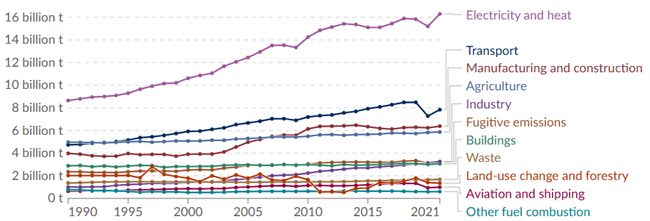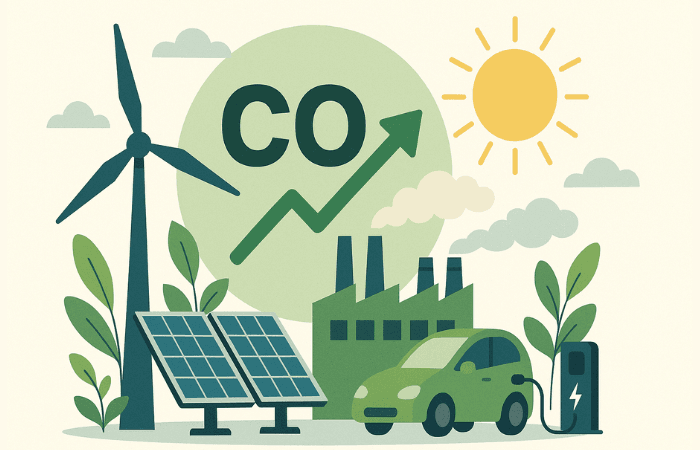Decarbonisation
The Great Project of Our Age
There was a time, not long ago, when coal smoke rising from the stacks was taken as a symbol of progress. Now we know it was also the price of a warming world. Decarbonisation is the unravelling of that bargain, the deliberate turning away from fossil-fuelled triumphs toward a cleaner, steadier horizon.
What is Decarbonisation?
Decarbonisation means reducing carbon dioxide (CO₂) and other greenhouse‑gas emissions from our energy use, transport, industry, buildings, agriculture and more. It includes switching to low‑carbon energy, improving efficiency, and employing technologies that remove CO₂ from the atmosphere.
It is the art of pulling the carbon thread out of the fabric of our economies without unravelling the fabric itself.
It means replacing the roaring furnaces with quiet grids of solar panels, shifting the weight of industry from coal and oil onto hydrogen and electrification, and capturing the invisible gases like CO₂ that we once let drift into the air without a thought.
Why is Decarbonisation Important?
The numbers tell a sobering story. 2023, In 2023, human activities released about 37.1 billion metric tonnes of CO₂ into the atmosphere. Left unchecked, sectors such as energy, transport, industry and agriculture will keep driving us toward a world hotter, harsher, and more uncertain.
The Paris Agreement offers hope and a promise: keep the rise in global temperature well below 2 °C, preferably near 1.5 °C. But promises mean little without action. Decarbonisation is that action pathway to make our planet liveable. Without it, the costs will be written not just in currency but in coastlines lost, harvests ruined and lives diminished.

Source: Our World in Data
Examples of Decarbonisation
Power generation:
Transition from coal and gas to renewables, backed by grid upgrades and storage.
Industry
Heavy sectors like steel, cement and chemicals must adopt low‑carbon heat (e.g. green hydrogen), electrify where possible, and embrace carbon capture.
Transport
Road electrification and cleaner freight, sustainable aviation fuels (SAFs), efficiency gains, and eventually hydrogen or electric aviation technologies.
Shipping
The International Maritime Organisation aims to reduce emissions by 40% by 2030 compared to 2008 levels, with goals for net‑zero around mid‑century using green fuels.
Data Centres
Morgan Stanley estimates that data centres will emit 2.5 billion tonnes of CO₂‑equivalent by 2030. The growth in hyperscale computing is spurring investments in clean energy, energy‑efficient hardware, green construction, and carbon removal technologies.
Each example is a thread in the tapestry of decarbonisation, all different but all necessary.

Carbon Dioxide Removal (CDR) as a Decarbonisation Solution
Carbon Dioxide Removal (CDR) are technologies designed not just to reduce future emissions, but to draw down the legacy carbon already adrift in the atmosphere.
Bioenergy with Carbon Capture and Storage (BECCS)
Grow biomass, burn it for energy, capture the carbon at the stack, and store it safely underground.
Enhanced Rock Weathering (ERW)
Spread finely ground minerals across fields and as they dissolve, they bind with CO₂, removing it from the air.
Ocean Alkalinity Enhancement
Adjust the chemistry of the seas so that they absorb more carbon, turning the oceans into vast, natural allies.
For more CDR options and details, see: Carbon Dioxide Removal Technology
Together, CDR technologies are not an alternative to cutting emissions but a complement and a way of balancing the atmospheric books when reduction alone will not suffice.
Direct Air Capture (DAC) as a Decarbonisation Solution
Imagine a vast machine that breathes like a forest, but faster with fans pulling in the air and adsorbents removing the carbon dioxide we can no longer ignore. That is Direct Air Capture.
For more details:
What is Direct Air Capture?
How Does Direct Air Capture Work?
Advantages of Direct Air Capture
DAC is proving to be useful in a number of applications.
DAC’s Role in Key Sectors
Aviation
Aviation accounts for around 2.5 % of global CO₂ emissions and closer to 4 % of actual warming when non‑CO₂ effects like contrails are included (KPMG). With demand rising, aviation’s share could grow significantly by 2050 unless offset. DAC combined with green hydrogen to make e-SAF offers a way to neutralise or offset unavoidable emissions.
Transport (beyond aviation)
While electrification is advancing, heavy goods and long‑distance logistics still generate hard‑to‑eliminate emissions. DAC enables offsetting these residual emissions or producing low‑carbon synthetic fuels.
Data Centres
With rapid growth in demand, data centres are a notable emitter. DAC offers one means to offset such emissions if clean‑energy reliance or efficiency improvements can’t fully eliminate them. Furthermore, Direct Air Capture systems can be co-located with data centres to use their waste heat and so lower the energy cost of carbon capture.
Heavy Industry
Hard-to-abate industries like cement and steel are difficult to electrify. DAC, as a negative‑emissions approach, can help offset residual emissions once cleaner processes are maximised. As with the data centres, DAC can make use of low grade waste heat that is emitted from industrial processes.
For more, see: Direct Air Capture + Waste Heat Use Cases
Overview of Decarbonisation Regulations
EU Regulations
European Climate Law
- Sets a legally binding target of net zero greenhouse gas (GHG) emissions by 2050, with an intermediate target of at least ‑55 % by 2030 (compared to 1990 levels).
- Fit for 55 is the policy package designed to deliver that 55% reduction, covering energy, transport, and industry. ReFuelEU Aviation sits within Fit for 55 and specifically targets aviation by mandating increasing shares of sustainable aviation fuel (SAF).
Carbon Border Adjustment Mechanism (CBAM)
- Effective from 2026 (reporting began in 2023), CBAM imposes a carbon tariff on imports of steel, cement, fertilisers, aluminium, electricity, hydrogen to prevent carbon leakage and align import costs with EU producers’ costs under the ETS.
EU Emissions Trading System (EU ETS)
- A key cap‑and‑trade scheme covering emissions from power plants, heavy industry, aviation, and more. The overall cap in 2024 was approximately 1,386 Mt CO₂e (ICAP Carbon Action).
Clean Industrial Deal
- Launched in February 2025, this package aims to cut emissions from energy‑intensive industries and accelerate renewable infrastructure rollout by establishing a new €100 billion Industrial Decarbonisation Bank.
Ireland Regulations
Climate Action and Low Carbon Development (Amendment) Act 2021
- Legally binds Ireland to net‑zero by 2050 and an interim 51 % emissions reduction by 2030 (relative to 2018) through a strengthened governance framework IEA.
Final Thoughts on Decarbonisation
Decarbonisation now rests on a mix of strategies: shifting to clean energy, boosting efficiencies, electrifying transport, using green fuels, and transforming heavy industry. But for hard-to-abate sectors that remain tough to decarbonise, DAC offers a safety net. DAC is one of the few scalable options to genuinely remove CO₂ after emission-reduction options have been exhausted.
And if the story is written well, perhaps the future will look back on this age not as a decline, but as the moment when the world finally began to breathe freely again.
For more:

